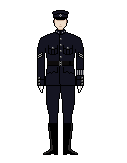Policing in Great Nortend
Law enforcement in Great Nortend is undertaken by regional constabularies commanded by appointed commissioners answering to the county sheriff and thence to the King's lieutenant. Policing is under the ministerial jurisdiction the Constabularies Office of the King's Clerk who coordinates the regional constabularies on a national level.
As officers of the Crown, police constables swear allegiance to the Sovereign and exercise his prerogative of ensuring peace. Despite being a civilian force, policemen routinely carry small arms. Their duties include deterring crime by patrolling the streets (“walking the beat”), investigating crime, dealing with breaches of the peace, enforcing the law and giving help to the public.
Organisation
The first police forces evolved from the mediaeval system of watchmen, constables and other parish officers who were charged with the maintenance of the peace. In the 19th century, this developed into a system of police constabularies by the Constabularies Act, 56 Edm. VII. which require the sheriff and yeomen of right of each county or borough to combine the existing ad hoc system of local policing into a centrally administered constabulary force.
The fifty-two constabularies formed under the Constabularies Act are organised on a county-by-county basis, under the ministerial control of the King's Clerk who has responsibility over domestic security and law enforcement.[1] This is exercised through the Under-Clerk for Constabularies who heads the Constabularies Office, a sub-office of the Clerk's Office. The Constabularies Office is the main liaison office between the Government and the police constabularies.
Structure
Operational policing is undertaken by bodies of constables known as constabularies, each whereof independent of another. There are 52 regular constabularies and 30 special constabularies.[1] Each has a particular territorial jurisdiction known as a constablewick. Most constabularies have a constablewick over an entire county. Twelve boroughs have their own independent constabularies, although most boroughs share their constabulary with the wider county.
Most constabularies are organised in a hierarchy of four levels :—[2]
- Parish
- There is a police house in most parishes. An Underconstable, Constable or Serjeant is in charge of the police house, assisted by lower ranks.
- Subdivision
- A subdivision consists of several parishes in a locality commanded by an officer of the rank of Intendent. A Superintendent is based in the largest settlement of the subdivision, where a police station is located.
- Division
- A division is a grouping of subdivisions corresponding to a hundred or a group of hundreds or a borough. It is commanded by the High Constable of the hundreds within the division. Most constabularies have around eight to ten divisions.
- Constabulary
- Commissioners, Under-Commissioners and Tipstaves operate from the constabulary headquarters. Each constabulary has a D. S. division (Detective Services division) and an S. S. division (Special Services division). The former is tasked with investigative and detective police work whilst the latter encompasses a variety of different branches such as the Dog Branch, the Mounted Branch, the Firearms Branch and the Security Branch.
Ranks
The Constabularies Act did not abolish the traditional offices of constable, high constable and sheriff who were the officers of the peace for a parish, hundred/borough and county respectively. Rather, it formalised the existing system of ad hoc assistants, deputies and deputies of deputies over several different recognised offices, titled inter alia watchmen, underconstables, beadles, bailiffs, undertipstaves and tipstaves. This ensured that all such officers of the peace had a constable's customary powers.[1]
As such, any policeman may exercise his statutory powers anywhere in Great Nortend. Furthermore, the Lady Constables Act, 10 Edm. IX., permitted women to join constabularies for the first time, with most of the statutory and customary law powers of male constables. Lady constables are, however, restricted to the ranks of watchman, underconstable, constable and beadle.[3]
Uniform
As a civilian service, policemen wear blue standing-collar tunics for their daily undress operational uniform, often with knee boots and overalls and a peaked forage cap for headdress. Lady constables wear skirts instead of overalls. All carry a whistle and a wooden truncheon, and around two thirds carry small arms.[4] Many constabularies wear helmets as part of the police uniform, instead of the forage cap.
Instead of full dress or mess dress as worn by the Armed Forces, civilian morning and evening dress are worn as appropriate when not on duty.[5]
References
This page is written in Erbonian English, which has its own spelling conventions (colour, travelled, centre, realise, instal, sobre, shew, artefact), and some terms that are used in it may be different or absent from other varieties of English. |






